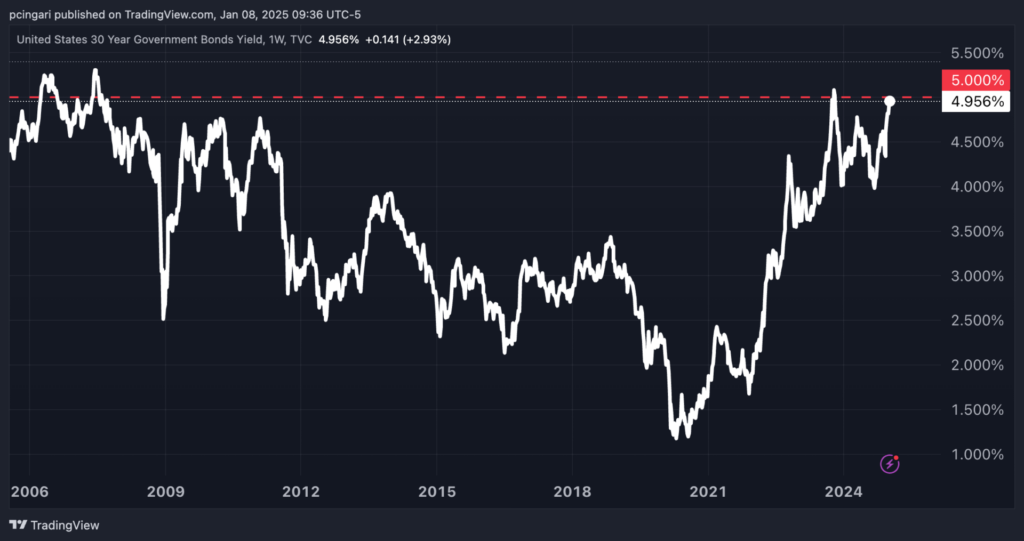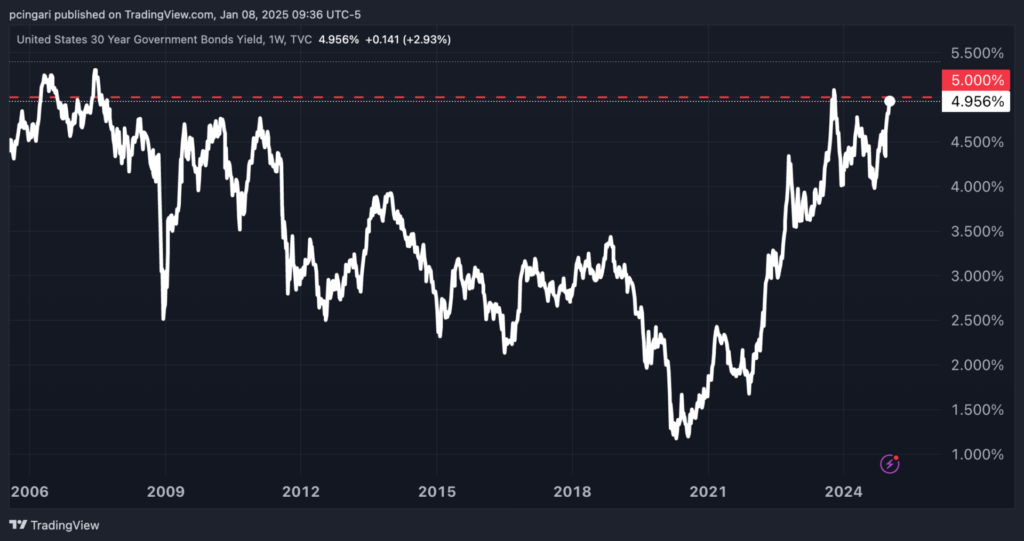
The U.S. dollar extended its rally to a 14-month high and Treasury yields continued their relentless rise on Wednesday as speculation grew that President-elect Donald Trump is considering invoking sweeping emergency powers to implement new tariffs, fueling fears of inflation and policy uncertainty.
According to an exclusive CNN report on Wednesday, sources familiar with the matter said Trump is mulling the use of the International Economic Emergency Powers Act to declare a national economic emergency.
This move could enable him to impose significant tariffs on imports without requiring congressional approval or the need to justify the tariffs on national security grounds.
Yet, sources told CNN that no final decision has been made regarding the declaration of a national emergency.
Dollar’s Remarkable Rally, 30-Year Yields Near 5% Danger Zone
A measure of the greenback strength, tracked by the Invesco DB USD Index Bullish Fund ETF UUP, climbed to the highest levels since November 2023, up for the sixth consecutive week.
The euro fell 0.4% to $1.03 and the British pound slumped 1.2% to $1.2340, with the latter hitting its weakest level since April 2024.
The dollar has now rallied in 14 of the last 15 weeks as investors expect Trump’s tariffs to damage other currencies.
“Perhaps more than even during his last term of office, traders will need to pay close attention to everything coming from the new president,” said David Morrison, senior market analyst at Trade Nation.
Meanwhile, the 30-year Treasury yield surged to 4.95%, inching closer to the critical 5% mark. Yields on longer-dated bonds, highly sensitive to inflation expectations, signal renewed fears of rising costs fueled by Trump’s tariff threats and their potential disruption of global supply chains.
“The incoming Trump administration’s policies can lead to increased market volatility,” wrote Bank of America Securities on Tuesday.
The iShares 20+Year Treasury Bond ETF TLT – the world’s largest Treasury-linked exchange traded fund – has fallen by more than 7% since Trump’s election victory in November.
The last time 30-year Treasury yields crossed the 5% threshold was in October 2023, a level previously unseen since July 2007.
“Trump’s proposed immigration and tariff policies will boost U.S. inflation temporarily, limiting the Fed’s ability to cut interest rates,” said Capital Economics in a recent report.
“The probability of an equity drawdown has increased to almost 30%,” Goldman Sachs’ analyst wrote in a report on Wednesday. Analysts Andrea Ferrario and Christian Mueller-Glissman highlighted that “most of the increase in drawdown probability has been driven by inflation momentum turning from negative to positive.”
Chart: 30-Year Treasury Yields Head Toward 5% Threshold

What’s Behind Trump’s Plan?
During a press conference on Tuesday at Mar-a-Lago, Trump called for aggressive measures to rebalance trade and geopolitical relationships with key partners, targeting Canada, Mexico, Europe and China.
His comments included sharp criticisms of trade deficits, defense spending disparities, and alleged unfair practices.
On Canada, Trump said, “Why are we supporting a country with a $200 billion-plus deficit? Our military is at their disposal, and we give them so many subsidies.”
He floated the provocative idea of Canada becoming the 51st U.S. state if economic relations didn’t improve.
With Mexico, Trump reiterated his long-standing frustrations, stating, “We are going to put very serious tariffs on Mexico… drugs are coming through at record numbers.” He accused the Mexican government of failing to control cartels and migration flows into the U.S.
On European countries, Trump reiterated the call for increased defense expenditure, emphasizing that NATO members delinquent on meeting the 2% of GDP target would not receive U.S. military protection. He described the current benchmark as insufficient, saying, “It should be 5%, not 2%.”
Trump also floated the idea of acquiring Greenland, cautioning Denmark about the possibility of imposing tariffs.
As for China, Trump expressed concern about the country’s influence in strategic areas like the Panama Canal and the Arctic.
“China is at both ends of the Panama Canal. They’re running it,” he said, calling for renewed U.S. focus on containing Beijing’s geopolitical ambitions.
Read now:
Photo: Shutterstock
© 2025 Benzinga.com. Benzinga does not provide investment advice. All rights reserved.